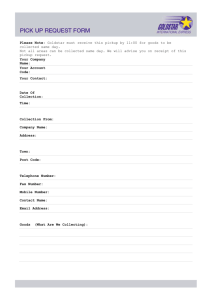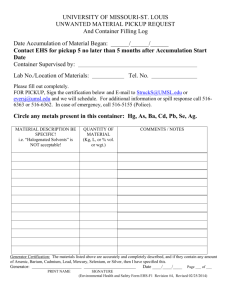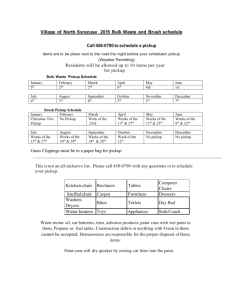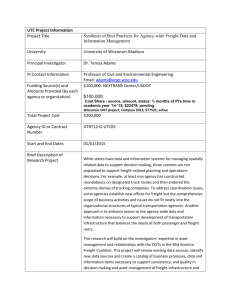Professor Goodchild CEE 500
advertisement
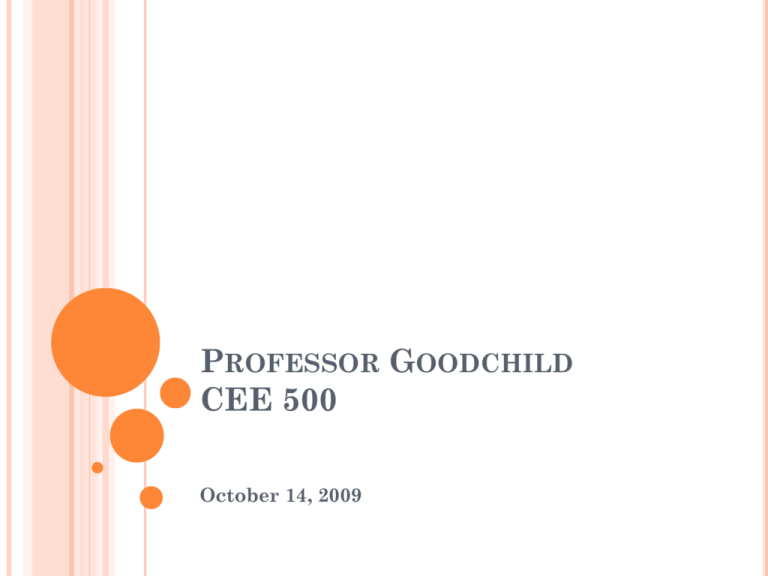
PROFESSOR GOODCHILD CEE 500 October 14, 2009 CONSULTING Applied Decision Analysis, Menlo Park CA PricewaterhouseCoopers, London UK BACKGROUND MS, PhD Civil and Environmental Engineering UC Berkeley BS Mathematics UC Davis Joined UW 2005 after completing my PhD TEACHING CEE 320 – Introduction to Transportation Engineering CEE 500 – Transportation and Construction Seminar CEE 587 – Global Trade, Transportation Logistics Management (GTTL Core 1 course) CEE 100 – Exploring Civil and Environmental Engineering ENVIR 512 – Environmental Management Keystone Project RESEARCH INTERESTS Freight Transportation and Logistics Freight Policy Analysis Reducing Externalities from Freight to Improve Sustainability http://international.fhwa.dot.gov/scan/2010/images/01.jpg 10 FREIGHT TRANSPORTATION CHALLENGES Reduce externalities from freight activity Without un-necessarily disrupting economic activity Improve transportation at intermodal interfaces Marine ports International borders Improve the freight transportation system’s ability to accommodate disruptions Prioritize trips that contribute most to the state’s economy Identify data needs, methods, and tools FREIGHT TRANSPORTATION NEEDS Address further complexity in the relationships that contribute to decision making about freight system use Interactions between agents at intermodal interfaces Model decision making and incentives Widely available operational data Relationships between cost, service, demand, and emissions NEAR BORDER OPERATIONS What is the impact of the border on logistical efficiency? Cabotage laws Size and weight restrictions How does this vary by commodity, origin, and destination? Previous research describes: Impact of travel time variability on regional supply chains Profile of Cascade Gateway Relationship between delay and demand Intra-industry trade analysis CASCADE GATEWAY TYPICAL ARRIVAL AND DELAY PATTERN Grubel-Lloyd index 2008 2007 2006 2005 2004 Imports Exports Grube-Lloyd Index (4 digit NAICS) Grubel-Loyd Index (3 digit NAICS) 100 90 80 70 60 50 40 30 20 10 0 $70 $60 $50 $40 $30 $20 $10 2008 2007 2006 2005 2004 2003 2002 2001 2000 1999 1998 1997 1995 1994 1993 $0 1992 Value in Billions (USD) $80 Grubel-Lloyd index Michigan & Ontario 1996 2003 2002 2001 2000 1999 1998 1997 1996 1995 1994 100 90 80 70 60 50 40 30 20 10 0 1993 $10 $9 $8 $7 $6 $5 $4 $3 $2 $1 $0 1992 Value in Billions (USD) B.C. & Washington Imports Exports Grube-Lloyd Index Grubel-Lloyd index (3 digit NAICS) CURRENT PROJECTS Urban Pick-up and Delivery Systems Trade-offs between cost, emissions, and service quality Amazon Fresh, Cascade Express, UW Mailing Service Implications of broad transportation replacement Relationships with land-use, policy 19 NETWORK WITHOUT CONGESTION Delivery 3 Pickup 3 Pickup 4 Pickup 1 Delivery 4 Delivery 1 20 Pickup 2 Delivery 2 RESULTS: NETWORK WITH CONGESTION Delivery 3 Pickup 3 Pickup 4 Pickup 1 Delivery 4 Delivery 1 21 Pickup 2 Delivery 2 RESULTS: 3 PERIODS Travel Time on link i Period 2 (congestion) Period 1 6:30 7:30 Period 3 9:00 10:00 22 RESULTS: ASSIGNMENT Delivery 3 Pickup 3 Pickup 4 Delivery 4 Pickup 1 Delivery 1 Pickup 2 Delivery 2 Dark veh, which pollutes more, is assigned to a 23 shorter route Minimal Cost Solution: Veh assigned differently (+2%) STATEWIDE FREIGHT MODELING Improving freight resilience Mapping important supply chains Developed first statewide freight model Improving link cost functions to better represent freight movement Understanding how DOTs can improve system resilience MAPPING DIESEL FLOWS terminal racks truck pipeline barge IMPROVING TRANSPORTATION EDUCATION Developing module for FHWA Distance learning Active learning Transportation Policy course development PREVIOUS RESEARCH Distribution of warehousing activity and the impact on transportation Modeling near port transloading activity Evaluating policies to reduce port trucking delay New models in North American port development Evaluating supply chain GHG emissions Air terminal operations Identifying airline charter potential Marine terminal operations

